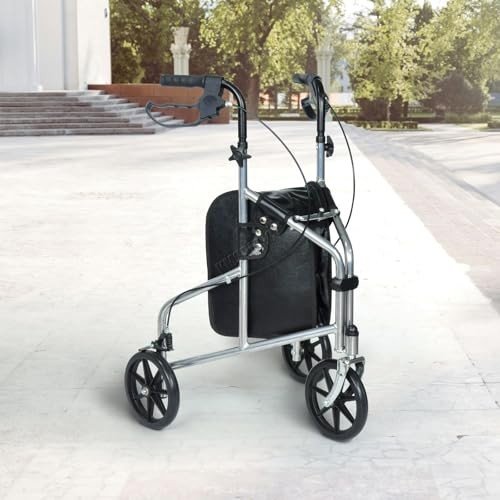Understanding Medical Walkers: A Comprehensive Guide
Medical walkers work as invaluable mobility aids for people recovering from surgery, managing persistent illnesses, or handling age-related mobility problems. These devices not just enhance physical self-reliance but likewise enhance safety, allowing users to browse their environments with higher ease. This short article checks out the types, benefits, features, and factors to consider associated with medical walkers, along with some frequently asked concerns.
Table of Contents
- Types of Medical Walkers
- Benefits of Using a Medical Walker
- Key Features to Consider
- Regularly Asked Questions
- Conclusion
1. Kinds Of Medical Walkers
Medical walkers are readily available in various styles, catering to various needs and choices. The primary types consist of:

| Type of Walker | Description |
|---|---|
| Requirement Walker | A rectangular frame with four legs, offering stability and support. |
| Two-Wheeled Walker | Comparable to a basic walker however equipped with wheels at the front for easier motion. |
| Three-Wheeled Walker | A lightweight walker with three wheels, enabling more maneuverability, ideal for indoor use. |
| Rollator Walker | A walker with 4 wheels, hand brakes, and a seat, suitable for longer ranges and resting needs. |
| Hemi Walker | Developed for people who can use just one hand, featuring a tripod-like style. |
2. Benefits of Using a Medical Walker
Using a medical walker provides a number of benefits that add to the user's total well-being, consisting of:
- Increased Stability: Walkers offer a stable base of support, minimizing the threat of falls.
- Improved Mobility: They make it possible for users to walk around more quickly, promoting self-reliance.
- Discomfort Relief: By rearranging weight, walkers can ease discomfort in the joints, especially in the hips and knees.
- Posture Support: These gadgets motivate proper posture, lowering stress on the back.
- Boosted Confidence: Users often feel more secure using walkers, resulting in better self-confidence and increased activity levels.
3. Secret Features to Consider
When selecting a medical walker, it's crucial to evaluate numerous functions to discover the best fit. Here are some important aspects to consider:
- Weight Capacity: Ensure the walker can support the user's weight while preserving stability.
- Height Adjustment: Look for a walker with adjustable height settings to accommodate the user's height and provide comfortable grip.
- Material: Lightweight aluminum walkers are simpler to maneuver, while steel walkers use stronger assistance however might be much heavier.
- Wheel Quality: If choosing a wheeled walker, consider the wheel size and tread. Bigger wheels browse unequal surfaces more easily.
- Seat Availability: If users will be walking for longer periods, a walker with an integrated seat can supply rest breaks when required.
- Brakes: Hand brakes are especially important for safety in rollator walkers to control speed and stop when required.
Kinds of Walkers with Features Comparison Table
| Walker Type | Weight Capacity | Height Adjustment | Wheels | Seat Available | Brakes |
|---|---|---|---|---|---|
| Requirement Walker | As much as 300 lbs | Yes | No | No | No |
| Two-Wheeled Walker | Up to 300 lbs | Yes | Yes | No | No |
| Three-Wheeled Walker | Up to 250 lbs | Yes | Yes | No | No |
| Rollator Walker | As much as 400 lbs | Yes | Yes | Yes | Yes |
| Hemi Walker | Up to 250 lbs | Yes | No | No | No |
4. Often Asked Questions
Q1: Who must use a medical walker?A: Medical walkers are helpful for people recuperating from surgery, experiencing balance issues, or requiring help due to age-related mobility obstacles. Q2: Can a medical walker be adjusted?A: Yes, the majority of
medical walkers are height-adjustable to accommodate various user heights, permitting for a more comfortable grip. Q3: How do I pick the right walker for my needs?A: Consider elements such as the
user's weight, height, type of mobility concerns, and whether they require a seat or brakes. Testing the walker for convenience and stability before purchase is also suggested. Q4: Are there any safety suggestions connected with using a medical walker?A: Yes, users must guarantee they do not lean too
heavily on the walker, use it on steady and level surface areas, and always make sure
the brakes are engaged when seated or stationary. Q5: Can walking with a medical walker aid with rehabilitation?A: Absolutely. Medical walkers are frequently recommended as part of rehabilitation programs as they motivate
exercise, which aids in healing and mobility improvement. 5.
Conclusion Medical walkers play a vital role in improving the lifestyle for individuals dealing with mobility challenges. With various types and features readily available, choosing the right walker includes considering the user's specific needs and situations. By comprehending their benefits and proper use, individuals can restore independence, enhance their mobility, and browse their environments securely. Whether for short-term healing or long-term support, the ideal medical walker can considerably enhance a user's total well-being. Integrating a medical walker into one's day-to-day routine can be a transformative decision, making it simpler to take part in life's daily activities while making sure safety and confidence.